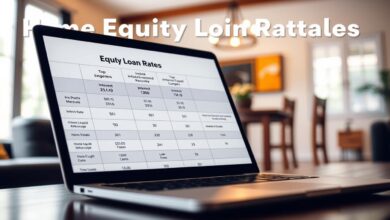Personal Loans: Compare Rates & Apply Online Today
Need extra funds for a big purchase or unexpected expense? You’re in the right place. This guide simplifies the process of finding financial solutions that fit your needs. Whether you’re consolidating debt or tackling home repairs, understanding your options is the first step toward smarter borrowing.
Major lenders like TD Bank, Scotiabank, and RBC offer competitive terms tailored to different budgets. For example, TD Bank provides up to $50,000 based on income and credit history, while RBC’s fixed and variable rate options adapt to changing financial goals. Current rates start as low as 4.95%, giving you flexibility without hidden fees.
We’ll walk you through comparing interest rates, repayment terms, and online application steps. Discover how to leverage tools that simplify decision-making and manage payments effortlessly. By the end, you’ll feel confident choosing between fixed predictability or variable rate potential.
Key Takeaways
- Compare rates from trusted lenders like TD Bank, RBC, and Scotiabank
- Borrow up to $50,000 with flexible repayment timelines
- Choose between fixed or variable interest rate structures
- Access online tools for easy application and payment tracking
- No prepayment penalties with select lenders
Introducing Personal Loans and Their Benefits
Looking for a financial tool that works as hard as you do? Modern lending options provide structured support for diverse goals, from everyday needs to life-changing plans. With fixed repayment schedules and competitive rates, these solutions help you take control without surprises.
Why Choose This Option?
Predictable payments make budgeting straightforward. Unlike revolving credit lines, you’ll know exactly when your balance hits zero. Many lenders offer rates lower than credit cards – TD Bank and Scotiabank clients often save 30%+ on interest by consolidating balances.
Top Ways to Use Your Funds
From kitchen upgrades to dream weddings, here’s how borrowers put their cash to work:
- Transform your living space with home renovations that boost property value
- Combine high-interest balances into one manageable payment
- Cover essential purchases like medical equipment or energy-efficient appliances
- Fund milestone events without draining savings accounts
Scotiabank’s structured plans help users save an average of $1,200 annually when refinancing debt. Whether you need $5,000 or $50,000, these tools offer clarity and control for smart financial moves.
The Loan Application Process Explained
Understanding how to navigate the application process saves time and reduces stress. Most banking institutions now offer multiple pathways to secure funds, adapting to digital preferences and traditional needs.
How to Apply Online
Existing customers enjoy the fastest route. Log into your account through your bank’s website or app. You’ll need basic details like income verification and identification. TD Bank and RBC users can complete submissions in under 15 minutes using saved card and employment information.
In-Person Application Scenarios
New clients or specialized requests often require branch visits. Scotia mandates appointments for retirement savings plan loans, while auto financing typically needs physical documentation review. Bring government-issued ID, proof of address, and recent pay stubs to speed up processing.
| Features | Online | In-Person |
|---|---|---|
| Time Required | 10-20 minutes | 45+ minutes |
| Documentation | Digital uploads | Physical copies |
| Support Options | Chat/email | Face-to-face |
| Approval Speed | 24-48 hours | Same day |
Need help? Scotia advisors answer calls at 1-800-472-6842. RBC’s team provides guidance at 1-855-807-2382. Whether you apply digitally or at a branch, preparation ensures smoother approval.
Fixed vs. Variable Rates: What You Need to Know
Choosing between fixed and variable rates shapes your financial journey. This decision impacts monthly budgets and long-term planning. Let’s break down how each option works in real-world scenarios.
Advantages of Fixed Interest Rates
Fixed rates lock in your interest percentage for the entire repayment period. Your payment stays identical whether the prime rate climbs or drops. TD Bank customers enjoy this stability even when the TD Prime Rate fluctuates.
This predictability helps plan expenses years ahead. You’ll know exactly when your balance hits zero. RBC’s fixed interest rate options work well for those prioritizing certainty over potential savings.
Considerations for Variable Interest Rates
Variable rates change with the Bank of Canada’s Overnight Rate. When rates fall, more payment goes toward your principal. This could shorten your repayment timeline. But rising rates increase interest costs, extending payoff dates.
RBC’s current prime rate sits at 4.950%, a key benchmark for variable products. These rates suit borrowers comfortable with some risk for possible rewards. Your payment remains the same, but the interest/principal split shifts with market changes.
Weigh security against flexibility. Fixed rates shield against economic surprises. Variable options might save money if rates trend downward. Your financial goals and risk tolerance guide this crucial choice.
Understanding Personal Loans Options
Finding the right financial partner starts with understanding lender-specific features. Major institutions offer distinct solutions tailored to different budgets and goals. Let’s explore how these choices could work for your situation.
Tailored Solutions From Leading Providers
Scotia Plan Loans stand out with five-year terms and payment flexibility. Borrowers can adjust repayment schedules and skip one payment annually without penalties. This helps manage unexpected expenses while staying on track.
TD’s offerings shine for larger projects. Qualified applicants access up to $50,000 based on income verification. Their streamlined process suits urgent needs like medical bills or home upgrades.
RBC balances predictability with adaptability. Choose between one-to-five-year terms and fixed/variable rates. Their hybrid approach works well for both risk-averse planners and market-savvy strategists.
Beyond Interest Rates
Smart comparisons look at three key factors:
- Prepayment privileges to reduce interest costs
- Customer support availability
- Protection plans for job loss or illness
Scotiabank’s skip-a-payment option provides breathing room during tight months. TD includes rate discounts for automatic payments. RBC offers insurance add-ons covering 12-month payment pauses during hardships.
Whether you prioritize flexible terms or robust safeguards, these options demonstrate how modern lending adapts to real-life challenges. Your ideal match depends on how you balance immediate needs with long-term plans.
Key Eligibility Criteria and Required Documents
Preparing your application starts with knowing what lenders require. Having the right paperwork ready speeds up approvals and helps you secure better terms. Let’s break down what you’ll need and why it matters.
Essential Documentation Checklist
Start with basic identification like a driver’s license or passport. Lenders need this to confirm your identity and residency status. Next, gather income verification – recent pay stubs for salaried workers or tax returns for self-employed professionals.
Don’t forget expense statements showing housing costs, utilities, and existing debts. These help lenders calculate your debt-to-income ratio. If using a co-signer, they’ll need to provide the same documents plus their credit history details.
The Role of Your Credit Score
Your credit score acts like a financial report card. Most lenders prefer scores above 650 for competitive rates. Higher scores often unlock lower interest charges and flexible repayment terms.
“A 720+ score can save borrowers $1,200+ in interest over five years,” notes a banking industry report. However, lenders also review employment history and income stability. Even with strong credit, inconsistent earnings could affect approval odds.
| Document Type | Employed | Self-Employed |
|---|---|---|
| Income Proof | Last 2 pay stubs | 2 years tax returns |
| Credit Check | FICO® Score 8 or similar model | |
| Debt Overview | Mortgage/rent + credit card statements | |
Remember: Co-signers undergo the same credit evaluation as primary applicants. Their strong financial profile could help offset weaker areas in your application.
Online Personal Loan Application Tips
Streamline your digital borrowing experience with smart preparation. Modern banking systems let you complete applications faster than ever – TD clients report 70% faster processing using saved credentials. Follow these strategies to avoid common pitfalls and secure favorable terms.
Simplifying the Process
Start with document organization. Keep pay stubs, ID copies, and expense reports in one folder. TD’s online portal auto-fills 40% of application fields for existing customers, cutting completion time by half.
Accuracy matters more than speed. Double-check employment dates and income figures before submitting. A single typo can delay approval by 3-5 business days. “Incomplete applications account for 28% of processing delays,” notes a recent financial services report.
Anticipate common questions about your credit history and payment habits. Lenders often ask for explanations of credit report entries or irregular income patterns. Prepare brief, truthful responses that showcase financial responsibility.
| Preparation Step | Common Mistakes | Time-Saving Fix |
|---|---|---|
| Document gathering | Missing tax forms | Use cloud storage |
| Form completion | Outdated employer info | Enable auto-update features |
| Final review | Overlooked fees section | Print checklist |
Track your application through your banking dashboard. Most lenders send status updates within 48 hours. If issues arise, contact support teams during off-peak hours for quicker resolutions.
Managing Loan Repayments and Terms
Mastering your repayment strategy transforms borrowing from stressful to manageable. Flexible schedules and clear terms help you stay on track while adapting to life’s changes. Let’s explore how to optimize your payment plan.
Payment Schedules and Options
Choose payment frequencies that align with your income flow. Options include weekly, bi-weekly, or monthly arrangements. RBC and Scotia clients can adjust dates and amounts through online portals – ideal for seasonal workers or freelancers.
Understanding Repayment Terms
Each payment chips away at your balance through two parts: interest and principal. Early payments focus more on interest, shifting toward principal over time. Shorter terms (1-3 years) save on interest but require higher monthly amounts. Longer agreements (4-5 years) ease cash flow but cost more overall.
| Term Length | Monthly Payment | Total Interest |
|---|---|---|
| 2 Years | $950 | $1,200 |
| 5 Years | $420 | $2,800 |
Prepayment Considerations
Extra payments directly reduce your principal balance. Scotia and RBC allow unlimited prepayments without fees – every $100 extra could shorten your term by months. Daily interest calculations mean early payments maximize savings. One borrower paid off a $15,000 balance 14 months early using holiday bonuses.
Use online calculators to test different scenarios. Adjusting payments by just $50/month might save hundreds in interest. Remember: consistency matters more than perfection. Even small, regular additions make a difference over time.
Insights from Leading Lenders on Interest Rates and Rates Management
Navigating today’s financial landscape requires smart tools and clear insights. Top institutions balance competitive rates with flexible management features to help borrowers stay ahead. Let’s explore how their strategies could work for your goals.
Bank Strategies for Rate Structures
RBC bases variable rates on their prime rate of 4.950%, adjusted quarterly. TD uses similar benchmarks but adds credit-based adjustments for tailored offers. Scotia often provides lower initial rates for applicants with strong payment histories.
Creditor insurance like LoanProtector® safeguards payments during job loss or illness. These optional plans add 0.5-1.5% to monthly costs but provide valuable security. Always compare coverage details before committing.
Digital Solutions for Financial Control
TD’s EasyWeb platform lets users adjust payment dates and track interest costs in real time. Scotia clients can make extra payments directly through their online account, reducing principal faster. RBC’s dashboard displays rate change alerts and amortization schedules.
These tools transform complex data into actionable information. Set up automatic payments through banking apps to avoid missed deadlines. With practice, you’ll manage rate changes and repayment timelines like a pro.









